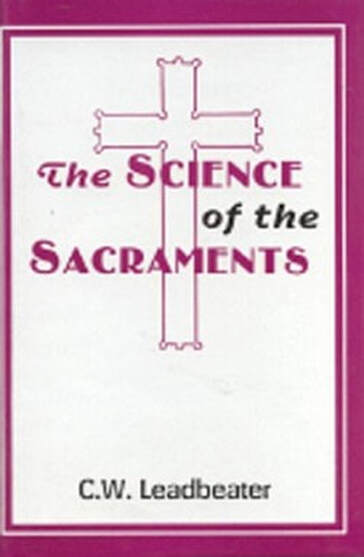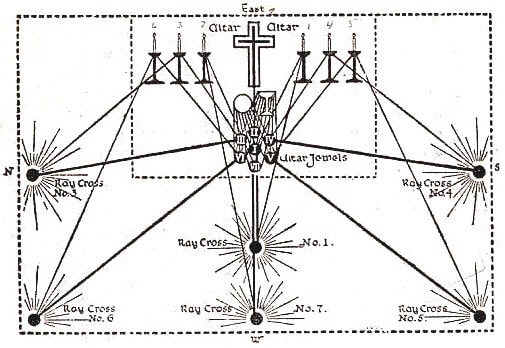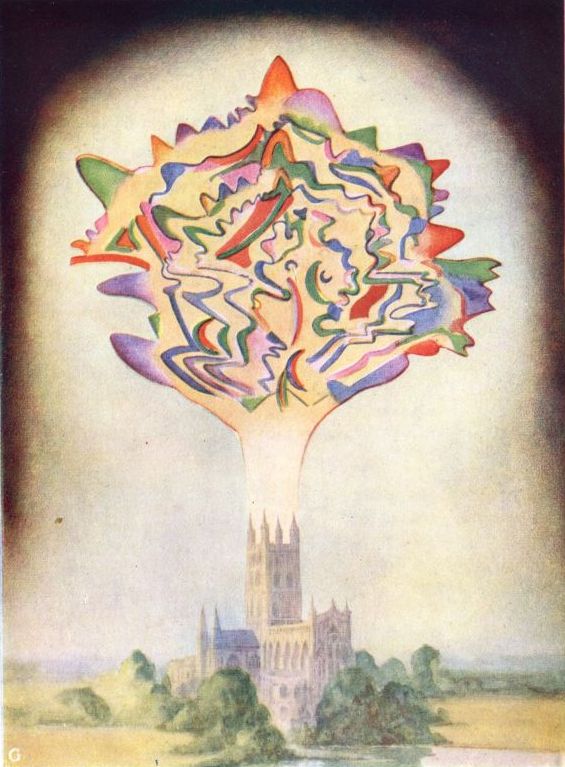for St. Gall’s Seminary
a review of ‘The Science of the Sacraments’ by Charles W. Leadbeater
17 January, 2020
Feast of St. Mildred of Thanet, Ab.
It is difficult to know what to say about Science of the Sacraments. Previously I had been familiar with Leadbeater’s magnum opus only abstractly, or from gleanings from other texts like Yoga of the Sacraments; reading the text itself and being able to have a full, original understanding of Liberal Catholic sacramental theology was extremely rewarding. My assertion, when reading Yoga of the Sacraments, that Burke’s interpretation could be read as a key to that of Leadbeater, seems to have been on-the-nose and I look forward to revisiting his work in light of that.
The main thrust of Science of the Sacraments, and the lynchpin around which the author arranges Liberal sacramental theology, can be singled out easily: astral architecture. Outlined in the book is an an energy-centric interpretation of the sacraments’ ultimate purpose and function; positing that there exists a ‘great reservoir of spiritual force’ set aside by God, and that ‘[t]he plan adopted by the Christ with regard to this religion is that a special compartment of [that reservoir] is set apart for its use, and that a certain order of officials is empowered, by the use of appointed ceremonies, words and signs of power, to draw upon it for the benefit of mankind.’ The most striking and laboriously-elucidated example of this channeling of divine power is the Holy Mass.
Leadbeater’s (and subsequently Liberal Catholicism’s) interpretation of the Mass is one of the LCC’s most seminal and original contributions to Christian philosophical discourse. Framed in the context of divine energies Leadbeater presents to us a liturgy and Eucharist which is at once familiar, yet alien. In the traditional (which is to say Latin) interpretation of the Eucharistic drama the Mass is a holy and eternal sacrifice; an Atonement offered again and again at every altar of the Lord. Venerable Fulton Sheen, famed television evangelist and later Archbishop of Rochester, once spoke of the Mass as the firm planting of the Cross on Golgotha; holding before us the true reality of Christ crucified. This view of the Mass is in many ways beautiful and profound, but is also utterly and completely at odds with the Liberal understanding of the Eucharist.
a review of ‘The Science of the Sacraments’ by Charles W. Leadbeater
17 January, 2020
Feast of St. Mildred of Thanet, Ab.
It is difficult to know what to say about Science of the Sacraments. Previously I had been familiar with Leadbeater’s magnum opus only abstractly, or from gleanings from other texts like Yoga of the Sacraments; reading the text itself and being able to have a full, original understanding of Liberal Catholic sacramental theology was extremely rewarding. My assertion, when reading Yoga of the Sacraments, that Burke’s interpretation could be read as a key to that of Leadbeater, seems to have been on-the-nose and I look forward to revisiting his work in light of that.
The main thrust of Science of the Sacraments, and the lynchpin around which the author arranges Liberal sacramental theology, can be singled out easily: astral architecture. Outlined in the book is an an energy-centric interpretation of the sacraments’ ultimate purpose and function; positing that there exists a ‘great reservoir of spiritual force’ set aside by God, and that ‘[t]he plan adopted by the Christ with regard to this religion is that a special compartment of [that reservoir] is set apart for its use, and that a certain order of officials is empowered, by the use of appointed ceremonies, words and signs of power, to draw upon it for the benefit of mankind.’ The most striking and laboriously-elucidated example of this channeling of divine power is the Holy Mass.
Leadbeater’s (and subsequently Liberal Catholicism’s) interpretation of the Mass is one of the LCC’s most seminal and original contributions to Christian philosophical discourse. Framed in the context of divine energies Leadbeater presents to us a liturgy and Eucharist which is at once familiar, yet alien. In the traditional (which is to say Latin) interpretation of the Eucharistic drama the Mass is a holy and eternal sacrifice; an Atonement offered again and again at every altar of the Lord. Venerable Fulton Sheen, famed television evangelist and later Archbishop of Rochester, once spoke of the Mass as the firm planting of the Cross on Golgotha; holding before us the true reality of Christ crucified. This view of the Mass is in many ways beautiful and profound, but is also utterly and completely at odds with the Liberal understanding of the Eucharist.
Whereas the Latin rite of the Mass is avowedly sacrificial, and maybe even penitential, Leadbeater interprets it in a new and joyous fashion; one that is profoundly influenced by the time in which he lived while at the same time revealing to us the true and eternal purposes for which Christ first instituted the Blessed Sacrament. It is here where astral architecture comes into play. As mentioned before the essential purpose of the sacraments is the utilisation of the ‘great reservoir of spiritual force’ which has been fashioned by the Lord. With this in mind we can better understand the methods by which the Mass accomplishes this. Says the Bishop:
Each of the great services of the Church (and more especially the celebration of the Holy Eucharist) was originally designed to build up a mighty ordered form, expressing and surrounding a central idea — a form which would facilitate and direct the radiation of the influence upon the entire village which was grouped round the church. The idea of the service may be said to be a double one: to receive and distribute the great outpouring of spiritual force, and to gather up the devotion of the people and offer it before the throne of God.
The creation of that ‘mighty ordered form’ and the subsequent functioning of that form is, in essence, the true purpose of the Mass (and to a variously lesser extent, the other sacraments as well) in Liberal Catholic theology. It is for this reason that Leadbeater often harshly dismisses the Latin Rite as inadequate for its true purpose; too weighed down with a fixation on sin to best receive and distribute the great outpouring of God’s energeia upon the world. Utilising his natural clairvoyant gifts the Bishop had an unsparing vision of the astral results of that fixation; describing a flat-roofed building that ‘is often a dead level of nervousness and anxiety, full of ugly hollows and pits of depression caused by the exaggerated confessions of vileness and abject appeals for mercy’ which pervaded the Roman canon. Seeing this, he was struck with the nature of the astral building as it should be:
Every such hollow should be replaced by a pinnacle of fervid devotion, updrawn by utter confidence in the love of God, so that the thought-form should show a forest of gleaming spires, like Milan Cathedral, instead of the flat or sagging roof which it often bears at present, in order that by sympathetic influence its soaring lines might guide men’s thoughts upward, and wean them away from servile fear to trust, adoration and love.
Each of the great services of the Church (and more especially the celebration of the Holy Eucharist) was originally designed to build up a mighty ordered form, expressing and surrounding a central idea — a form which would facilitate and direct the radiation of the influence upon the entire village which was grouped round the church. The idea of the service may be said to be a double one: to receive and distribute the great outpouring of spiritual force, and to gather up the devotion of the people and offer it before the throne of God.
The creation of that ‘mighty ordered form’ and the subsequent functioning of that form is, in essence, the true purpose of the Mass (and to a variously lesser extent, the other sacraments as well) in Liberal Catholic theology. It is for this reason that Leadbeater often harshly dismisses the Latin Rite as inadequate for its true purpose; too weighed down with a fixation on sin to best receive and distribute the great outpouring of God’s energeia upon the world. Utilising his natural clairvoyant gifts the Bishop had an unsparing vision of the astral results of that fixation; describing a flat-roofed building that ‘is often a dead level of nervousness and anxiety, full of ugly hollows and pits of depression caused by the exaggerated confessions of vileness and abject appeals for mercy’ which pervaded the Roman canon. Seeing this, he was struck with the nature of the astral building as it should be:
Every such hollow should be replaced by a pinnacle of fervid devotion, updrawn by utter confidence in the love of God, so that the thought-form should show a forest of gleaming spires, like Milan Cathedral, instead of the flat or sagging roof which it often bears at present, in order that by sympathetic influence its soaring lines might guide men’s thoughts upward, and wean them away from servile fear to trust, adoration and love.
Our Holy Fathers in Christ were inspired to address this deficiency in purpose by substituting joy for sorrow in their selection of verses and psalms, and taking a more measured attitude toward the ‘cringing’ verses which they abhorred: ‘it was especially impressed upon us that no words should be put into the mouth of the priest or the congregation which they could not really mean.’ As Leadbeater noted in that passage, this was quite successful in relation to the type of thoughtform the Liberal Mass produces. Likewise I am again moved to agree with Fr. Sten von Krusenstierna that ‘we realize now that the new Liturgy was a masterpiece, and undoubtedly the two Bishops were deeply inspired when compiling and writing it.’
Having said that, however, I am once more reminded of the criticism I levelled at Esther de Waal’s lack of emphasis on the suffering and crucified Christ. Here I am distressed by what I feel is an unfair and possibly harmful negativity toward suffering expressed by both Leadbeater and, to a lesser extent, Bl. James I. Wedgwood. There is no doubt that their removal of such passages has resulted in something holy, but I wonder if something is not worse off for the total exclusion. Frequently in the examples of Roman liturgy in Science the Psalmist is of a sorrowful mind, crying out in danger or anguish for the strong arm of the Lord. These passages are uniformly jettisoned. Instead their Liberal counterparts speak of beauty, holiness, and joy. While this is of course wonderful and uplifting to the heart, I know I can often find solace in the entreaties alone of the Psalms. We often, perhaps most often, turn to Christ in times of hardship and I’m not sure that’s something which should be wholly excised from corporate worship.
There are so many things I found edifying from this book. Leadbeater’s remarks on angels and nature-spirits deserve ample commentary, and I haven’t even scratched the surface of what could be said only of the Eucharist. One thing, though, deserves specific consideration: the objective necessity of beauty. I am struck by the degree to which beauty is seen as imperative; and this is nowhere more clearly seen than in Leadbeater’s extensive discussion of thought-forms — necessary in the scheme of the Creator for the proper functioning and flow of divine energy. Thought-forms best suited to the purpose for which Christ instituted the sacraments have an objective look, and that look is… beautiful. Gothic spires and soaring elegance contrasted against the ugly Le Corbusier edifices which are the objective result of deficiencies.
I believe this stakes out a uniquely Liberal Catholic position on beauty. Although many branches of Christ’s Etz Chaim make some acknowledgement of the ontological reality of beauty we alone claim that beauty is necessary to the economy of Salvation. To us, high-churchmanship is not an aesthetic preference to be bulldozed by aesthetic architectural fashions — without beauty the divine energies of Christ struggle to be brought down and dispensed throughout the world. Leadbeater tells us that the objective astral shape of dismal, ineffective worship bears a striking resemblance to Brutalism or Minimalism. Surely those are not suitable garments for Houses of the Lord, nor their furnishings, nor for vestments and vessels of the Work of God; and surely we can do better by imitating the graceful beauty of those edifices which channel best the energeia of Life Himself.
In The Science of the Sacraments I found the definitive proof that this branch of Faith, this holy understanding we call Liberal Catholicism, is a thing of joy and majesty given up to the Lord. I feel incredibly blessed to have ended up here, approaching ordination in this lineage of the Risen Master, as opposed to the many places I could have ended up at this point in my journey — that I have found rest with this Christ.
Having said that, however, I am once more reminded of the criticism I levelled at Esther de Waal’s lack of emphasis on the suffering and crucified Christ. Here I am distressed by what I feel is an unfair and possibly harmful negativity toward suffering expressed by both Leadbeater and, to a lesser extent, Bl. James I. Wedgwood. There is no doubt that their removal of such passages has resulted in something holy, but I wonder if something is not worse off for the total exclusion. Frequently in the examples of Roman liturgy in Science the Psalmist is of a sorrowful mind, crying out in danger or anguish for the strong arm of the Lord. These passages are uniformly jettisoned. Instead their Liberal counterparts speak of beauty, holiness, and joy. While this is of course wonderful and uplifting to the heart, I know I can often find solace in the entreaties alone of the Psalms. We often, perhaps most often, turn to Christ in times of hardship and I’m not sure that’s something which should be wholly excised from corporate worship.
There are so many things I found edifying from this book. Leadbeater’s remarks on angels and nature-spirits deserve ample commentary, and I haven’t even scratched the surface of what could be said only of the Eucharist. One thing, though, deserves specific consideration: the objective necessity of beauty. I am struck by the degree to which beauty is seen as imperative; and this is nowhere more clearly seen than in Leadbeater’s extensive discussion of thought-forms — necessary in the scheme of the Creator for the proper functioning and flow of divine energy. Thought-forms best suited to the purpose for which Christ instituted the sacraments have an objective look, and that look is… beautiful. Gothic spires and soaring elegance contrasted against the ugly Le Corbusier edifices which are the objective result of deficiencies.
I believe this stakes out a uniquely Liberal Catholic position on beauty. Although many branches of Christ’s Etz Chaim make some acknowledgement of the ontological reality of beauty we alone claim that beauty is necessary to the economy of Salvation. To us, high-churchmanship is not an aesthetic preference to be bulldozed by aesthetic architectural fashions — without beauty the divine energies of Christ struggle to be brought down and dispensed throughout the world. Leadbeater tells us that the objective astral shape of dismal, ineffective worship bears a striking resemblance to Brutalism or Minimalism. Surely those are not suitable garments for Houses of the Lord, nor their furnishings, nor for vestments and vessels of the Work of God; and surely we can do better by imitating the graceful beauty of those edifices which channel best the energeia of Life Himself.
In The Science of the Sacraments I found the definitive proof that this branch of Faith, this holy understanding we call Liberal Catholicism, is a thing of joy and majesty given up to the Lord. I feel incredibly blessed to have ended up here, approaching ordination in this lineage of the Risen Master, as opposed to the many places I could have ended up at this point in my journey — that I have found rest with this Christ.




 RSS Feed
RSS Feed
